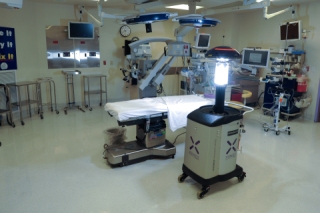Aug 11 2015
Nicklaus Children’s Hospital has acquired a Xenex germ-zapping robot, the most advanced disinfection technology available, in its continued effort to further enhance the cleanliness of its operating rooms. The robot destroys contagious superbugs in the hospital’s operating rooms in just minutes.
 Nicklaus Children's Hospital is using a Xenex germ-zapping robot, the most advanced disinfection technology available, to further enhance the cleanliness of its operating rooms. (Photo: Business Wire)
Nicklaus Children's Hospital is using a Xenex germ-zapping robot, the most advanced disinfection technology available, to further enhance the cleanliness of its operating rooms. (Photo: Business Wire)
The Xenex germ-zapping robot uses pulsed xenon ultraviolet (UV-C) light that is hundreds of times more intense than sunlight to effectively eliminate harmful superbugs, including Clostridium difficile (C.diff), MRSA, influenza and Ebola. This portable device is being used as an extra layer of patient protection in Nicklaus Children’s operating rooms after hospital staff has done a thorough cleaning of the area.
Nicklaus Children’s is the first children’s hospital in South Florida to use this technology and joins nearly 300 other hospitals nationwide using the robot. The Xenex room disinfection system has been credited with helping U.S. healthcare facilities reduce their rates of infection.
“At Nicklaus Children’s Hospital, patient safety is of utmost priority. The robot is a testament to our ongoing commitment to using the latest technology to support our infection prevention protocols,” said Jackie Gonzalez, DNP, ARNP, MBA, NEA-BC, FAAN, Senior Vice President, Chief Nursing Officer and Patient Safety Officer.
Because the Xenex robot uses pulsed xenon UV light to disinfect rooms, it is able to safely reach every surface in the room and does not leave any chemical residue. To disinfect a room after standard cleaning procedures have taken place, a hospital employee wheels the robot into the room, begins the automated sequence, and then leaves the room to allow the robot to eliminate bacteria in a five-minute cycle.
Source: http://www.xenex.com